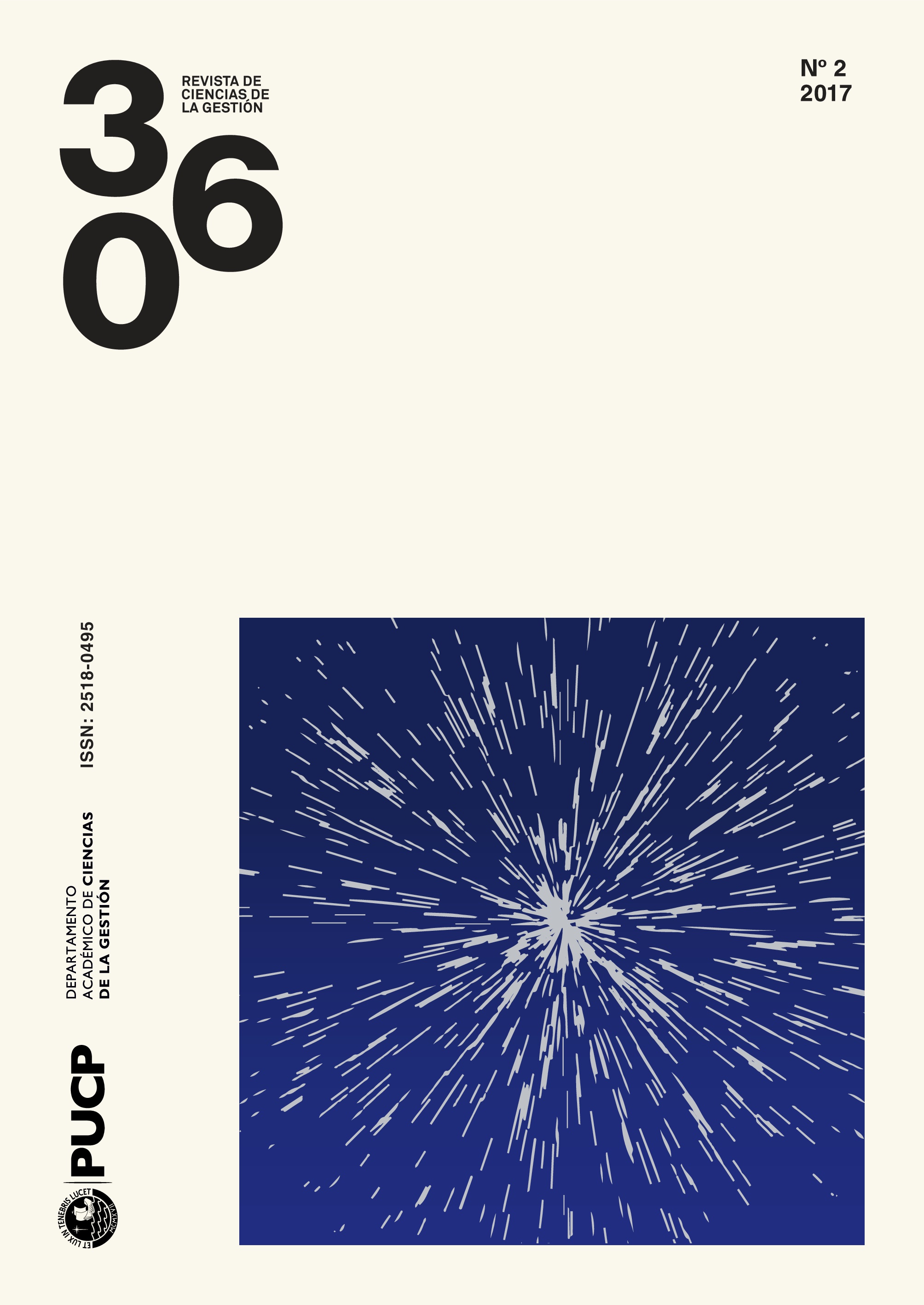Educating innovative and critical thinking managers
DOI:
https://doi.org/10.18800/360gestion.201702.002Palabras clave:
pensamiento crítico, educación en gestión, enseñanza, innovación, aprendizajeResumen
El pensamiento crítico ha sido reconocido como una competencia para la vida y un componente básico de la creatividad y de la innovación. Asimismo, es considerado como una experiencia profesional clave para las organizaciones de todo el mundo. El objetivo de este trabajo es proponer diferentes maneras de enseñar el pensamiento crítico a los futuros administradores para que estén preparados para resolver de manera innovadora las situaciones desafiantes en las organizaciones, aplicando dicho tipo de pensamiento. Esto se logra compartiendo los resultados de la investigación y las herramientas para la educación gerencial.
Descargas
Citas
Aitken, R. & L. Deaker (2007) «Critical learning and reflective practice: An exploratory study using tape recorded journals». Marketing Education Review, 17 (1), pp. 1-5. Retrieved from: <https://doi.org /10.1080/10528008.2007.11488980>.
American Management Association (AMA) (2010) «AMA 2010 critical skills survey». Retrieved from: <http://www.amanet.org/training/ promotions/AMA-2012-Critical-Skills- Survey.aspx>.
Athanassiou, N., J. M. Mcnett & C. Harvey (2003) «Critical thinking in the management classroom: Bloom’s taxonomy as a learning tool». Journal of Management Education, 27 (5), pp. 533-555. Retrieved from: .
Bailin, S., R. Case, J. R. Coombs & L. B. Daniels (1999a) «Common misconceptions of critical thinking». Journal of Curriculum Studies, 31 (3), pp. 269-283. Retrieved from: .
Bailin, S., R. Case, J. R. Coombs & L. B. Daniels (1999b) «Conceptualizing critical thinking». Journal of Curriculum Studies, 31 (3), pp. 285-302. Retrieved from: .
Becerra, A. M. & La Serna, K. (2010) Las competencias que demanda el mercado laboral de los profesionales del campo económico-empresarial en la actualidad. Lima, Perú: Centro de Investigación de la Universidad del Pacífico.
Behar-Horenstein, L. S. & L. Niu (2011) «Teaching critical thinking skills in higher education: A review of the literature». Journal of College Teaching & Learning, 8 (2), pp. 25-42. Retrieved from: .
Bonwell, C. C. & Eison, J. A. (1991) Active Learning: Creating Excitement in the Classroom. ASHE-ERIC Higher Education Report No. 1. Washington D.C.: The George Washington University.
Browne, M. N. & Keeley, S. M. (2007) Asking the right questions: A guide to critical thinking. New Jersey: Pearson Prentice Hall.
Celuch, K. & M. Slama (1999) «Teaching critical thinking skills for the 21st century: An advertising principles case study». The Journal of Education for Business, 74 (3), pp. 134-139. Retrieved from: .
Dyck, B., K. Walker, F. A. Starke & K. Uggerslev (2012)«Enhancing critical thinking by teaching two distinct approaches to management». Journal of Education for Business, 87 (6), pp. 343-357.
Ennis, R. H. (1989) «Critical thinking and subject specificity: Clarification and needed research». Educational Researcher, 18 (3), pp. 4-10. Retrieved from: .
Lipman, M. (1988) «Critical Thinking--What Can It Be?» Educational Leadership, 46 (1), pp. 38-43.
Manpower (2015) «Talent shortage survey». Retrieved from: <http://www.manpowergroup.com/wps/ wcm/connect/manpowergroup-en/home/ thought-leadership/research-insights/talentshortage- 2015>.
Mclaughlin, H. & R. Thorpe (1993) «Action learning - A Paradigm in emergence: the problems facing a challenge to traditional management education and development». British Journal of Management, 4 (1), pp. 19-27. Retrieved from: .
Observatorio Laboral PUCP (2013) Análisis de la demanda laboral de egresados de pregrado. Lima: PUCP. Retrieved from: <https://btpucp.pucp.edu. pe/informes-ml/3046/>.
Online Student Support Services (OSSS) (2013) «Critical reading techniques». Retrieved from: <http://www2.open.ac.uk/students/ skillsforstudy/critical-reading-techniques. php>.
Paul, R. (1993) «The logic of creative and critical thinking». The American Behavioral Scientist, 37 (1), pp. 21-39
Paul, R. & L. Elder (1999) «Critical thinking: Teaching students to seek the logic of things, part II». Journal of Developmental Education, 23 (2), pp. 34-35. Retrieved from: <https://doi.org/10.1 177/0002764293037001004>.
(2001) The miniature guide to critical thinking: Concepts and tools. California: The Foundation for Critical Thinking. (2001) «Critical thinking: Thinking with concepts». Journal of Developmental Education, 24 (3), pp. 42-43. (2006) «Critical thinking: The nature of critical and creative thought». Journal of Developmental Education. 30 (2), pp. 34-35. (2008) The Thinker’s Guide to the nature and functions of Critical & Creative Thinking. California: Foundation for Critical Thinking Press.
Pockett, R. & R. Giles (eds.) (2008) Critical reflection: generating theory from practice: the graduating social work student experience. Sydney, Australia: Darlington Press.
Revans, R. W. (1982) «What is action learning?» Journal of Management Development, 1 (3), pp. 64-75. Retrieved from: .
Reynolds, M. (1997) «Towards a critical management pedagogy». In J. Burgoyne and M. Reynolds (eds.), Management Learning: Integrating perspectives in theory and practice (pp. 312-328). London: Sage. Retrieved from: .
(1999a) «Critical reflection and management education: Rehabilitating less hierarchical approaches». Journal of Management Education, 23 (5), pp. 537-553. Retrieved from: <https://doi.org/10.1177/1052562999 02300506>.
(1999b) «Grasping the nettle: Possibilities and pitfalls of a critical management pedagogy». British Journal of Management, 9, pp. 171-184. Retrieved from: <https://doi.org/10.1111/1467- 8551.00118>.
Szenes, E., N. Tilakaratna & K. Maton (2015) «The knowledge practices of ‘critical thinking’». In M. Davies and R. Barnett (eds.), The Palgrave Handbook of Critical Thinking in Higher Education. London: Palgrave Macmillan. Retrieved from: .
Siegel, K. (2012) «Critical thinking and education.» La Serena. Retrieved from: <http://www.cel. userena.cl/miel/Web.Admin/documentos/ CURSO1/Chile_Critical_Thinking_ course_2-12.ppt>.
Smith, G. F. (2003) «Beyond critical thinking and decision making: Teaching business students how to think». Journal of Management Education, 27 (1), pp. 24-51. Retrieved from: <>https:// doi.org/10.1177/1052562902239247>.
Snyder, L. G. & M. J. Snyder (2008) «Teaching critical thinking and problem solving skills». The Delta Pi Epsilon Journal, 50 (2), pp. 90-99.
TalentLens (2015) «TalentLens: About us». Retrieved from: <http://talentlens.com/about-us>.
Think WATSON (2015) THINK Watson: Training. Retrieved from: <>.
Trehan, K. & C. Rigg (2007) «Working with experiential learning: a critical perspective in practice». In M. Reynolds and R. Vince (eds.), Handbook of experiential learning and management education. Oxford: Oxford University Press.
Publicado
Cómo citar
Número
Sección
Licencia
Derechos de autor 2023 360: Revista de Ciencias de la Gestión

Esta obra está bajo una licencia internacional Creative Commons Atribución 4.0.













